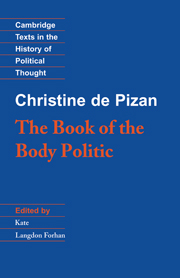Introduction
Published online by Cambridge University Press: 05 June 2012
Summary
Considered to be the first woman of letters of France, Christine de Pizan (c. 1364–c. 1430) was born in Venice. She was the daughter of Thomas de Pizan, medical doctor and astrologer, whose training at the prestigious University of Bologna brought him an appointment to the court of Charles V of France. In 1369 he settled his young family in Paris which became their permanent home. Christine was encouraged in her education both by her father and her young husband, Etienne du Castel, whom she married in 1380. Christine's love of learning and familiarity with court life brought their reward when she was suddenly left a young widow at the age of twenty-five, with three young children, a widowed mother, and an orphaned niece to support. Christine turned to a life of letters at first for consolation and later for income, writing a series of remarkable books that included works of poetry, biography, politics, chivalry, warfare, religion and philosophy for a variety of wealthy and noble patrons.
When The Book of the Body Politic was written between late 1404 and 1407, France was hovering on the brink of civil war. The intricate and complicated struggle between the French and the English commonly called the Hundred years War (1337–1453) was an extension of the conflict between these two developing nations that had begun in the twelfth century.
- Type
- Chapter
- Information
- The Book of the Body Politic , pp. xiii - xxivPublisher: Cambridge University PressPrint publication year: 1994



